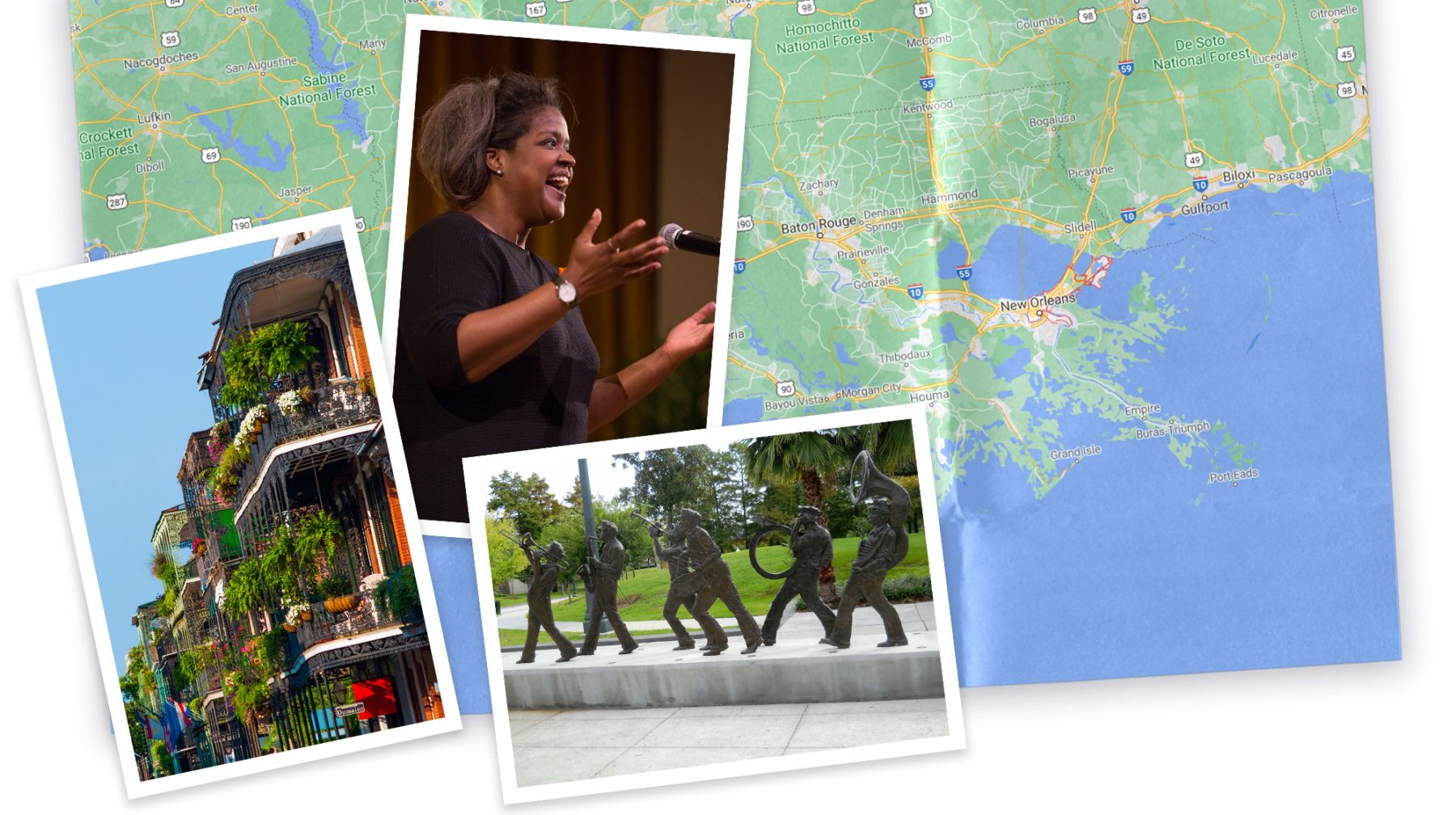
Gwen Thompkins celebrates the music of her home state every week on her comprehensive and joyful radio show.
Photos courtesy of the Nieman Foundation for Journalism at Harvard and from iStock
The center of the world
“Everybody recognizes the emotion in the music.”
Long before Gwen Thompkins embarked on a career in journalism that has taken her to nearly every continent, she grew up thinking that the world was New Orleans and New Orleans was the world. The music and musicians of her hometown — from Louis Armstrong to Mahalia Jackson to The Meters — were frequently on radio, in national magazines, and on television. Back then, she says with a huge laugh, she assumed, “in a pre-Copernican way, that New Orleans was the center of the world.”
All these years later, Thompkins is the co-creator, executive producer and host of “Music Inside Out,” a radio show that documents and celebrates Louisiana music and its impact on the wider world. “What we do is try to educate without appearing to educate. Give people a vocabulary to understand why they like the music they like, and to have a sense of where things come from,” Thompkins explained.
Thompkins started her career as a reporter and editor at The Times-Picayune newspaper and then moved to National Public Radio in Washington, where she edited “Weekend Edition with Scott Simon” and later traveled extensively as a foreign correspondent. While she found music wherever she went (“They played Usher” on a ship off the coast of Antarctica, she said) she never shook off the notion that the sounds of New Orleans are special.
Thompkins said part of the reason why is that music is so interwoven into the culture of the city.
On brass bands parading on the street: “There’s no stage. They have to speak for and to the people they are standing right next to.”
On traditional jazz funerals: “A brass band plays dirges as the family and second-liners leave the service. And when they, as we say, ‘cut the body loose’ on the way into the cemetery, they begin to play the joyful music, to celebrate life.”
On New Orleans at the beginning of rock ‘n’ roll: “Rock ‘n’ roll is considered a music of rebellion — which is essentially people who are trying to create a different reality for themselves. And that’s what you hear in the music of Rock and Roll Hall of Famers Dave Bartholomew and Fats Domino, and Cosimo Matassa, the engineer who recorded them and so many others in a segregated city.”
On music that works for all occasions: “When you just want to dance, Professor Longhair is there for you; if you want to feel something, Professor Longhair is there for you.”
These aspects help explain why New Orleanians love music so much: It’s part of everyday life and natural to virtually any ceremony or activity. But Thompkins went on to highlight another element that influences the city’s musical contributions to the world. “One of the reasons why I believe, and others do as well, that New Orleans has influenced American popular music to the degree that it has — beginning with the slaves at Congo Square in the late 1600s, all the way through until freedom — is that people decided to put their feelings in the music, and their dreams of freedom, dreams of relevance, of equality, this is what people are singing about,” Thompkins said. “Everybody recognizes the emotion in the music.”
After her post in East Africa, Thompkins further refined her art of storytelling as a Nieman Fellow at Harvard University. Storytelling, she says, “is the only thing I really care about in life.”
And that care comes through in her work. “Music Inside Out” comes across as equal parts documentary and confession, taking deep narrative dives into the lives of Louisiana legends Charles Neville and Big Freedia, as well as other musicians like classical violinist Nadja Salerno-Sonnenberg and blues icon Taj Mahal, who’ve been inspired by Louisiana music.
Over its eight years, “Music Inside Out” has aired some revelatory moments, from the rhythm and blues guitarist Walter “Wolfman” Washington talking about his time spent in a psychiatric ward, to soul queen Irma Thomas describing a soul-sapping studio experience with James Brown, to a tribute to Fats Domino in which the Grammy award-winning piano player Jon Cleary demonstrates how a Domino song helped create an entirely new genre of music. When, in the late 50s, a New Orleans radio station played the song, “Be My Guest,” its signal just barely reached the shores of Jamaica. What Jamaicans heard was a pleasing melody that had lost its low notes over the weakened signal and gained an accentuated, plinking rhythm. As a result, Cleary says “Be My Guest” inspired the creation of ska and reggae music.
Moments and music like that can make listeners wonder, just as young Thompkins did, whether New Orleans really is the center of the world.
This story is part of the To Serve Better series, exploring connections between Harvard and neighborhoods across the United States.




